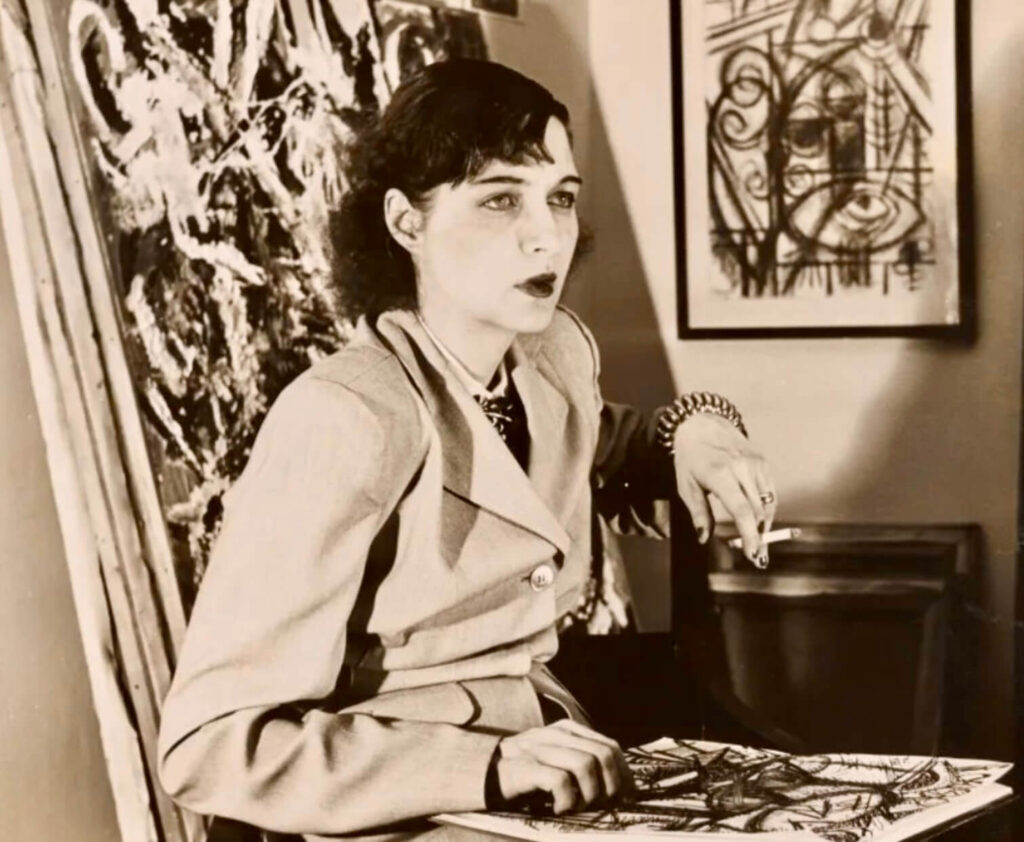Michael Corinne West
Michael (Corinne) West (1908-1991) was a pioneering figure in the Abstract Expressionist movement, known for her dynamic and vibrant paintings that embodied the spirit of the post-war American art scene. Despite the challenges she faced as a woman in a predominantly male-dominated art world, West’s work garnered respect and admiration for its boldness and innovation. Her legacy as an artist who pushed the boundaries of abstraction remains influential.

Early Life and Education
Born Corinne Michelle West on April 30, 1908, in Chicago, Illinois, she showed an early interest in the arts, particularly in music and painting. Her family moved to Ohio, where she attended high school before enrolling at the Cincinnati Art Academy in 1925. At the academy, she studied under the tutelage of Frank Duveneck, a prominent painter known for his influence on American Impressionism.
After graduating, West moved to New York City in the early 1930s, seeking to immerse herself in the burgeoning modern art scene. In New York, she enrolled in the Art Students League, where she studied under renowned artists such as John Sloan and Raphael Soyer. It was during this time that she began to develop her distinctive style, characterized by a bold use of color and dynamic compositions.
Transformation and Name Change
In the mid-1930s, West met the influential artist Arshile Gorky, who became her mentor and close friend. Gorky’s mentorship had a profound impact on her artistic development, encouraging her to embrace abstraction and to experiment with new forms and techniques. Under his influence, West’s work began to transition from figurative to abstract, and she adopted the name “Michael” to gain credibility in the male-dominated art world. This name change was not only a strategic move but also reflected her desire to break free from traditional gender roles and expectations.
Artistic Evolution and Style
Throughout the 1940s and 1950s, Michael West’s work evolved into a vibrant and dynamic expression of Abstract Expressionism. Her paintings were characterized by their bold, gestural brushstrokes, and energetic compositions. West was deeply influenced by the improvisational techniques of jazz music, which she often listened to while painting. This influence is evident in the rhythmic and spontaneous nature of her work.
West’s use of color was particularly distinctive. She often employed a vivid and contrasting palette, using bold primary colors alongside deep blacks and whites. Her compositions were marked by a sense of movement and fluidity, with swirling forms and overlapping layers of paint creating a dynamic visual experience. West’s paintings were not only visually striking but also conveyed a sense of emotional intensity and spontaneity.
Important Artwork: “Solar Allegro” (1957)
One of Michael West’s most significant works is “Solar Allegro” (1957). This painting exemplifies her mature style and her mastery of color and composition.
“Solar Allegro” (1957)
“Solar Allegro” is an oil on canvas that measures approximately 60 inches by 72 inches. The painting is a vibrant and dynamic exploration of color and form, with bold, sweeping brushstrokes and a rhythmic composition. The title “Solar Allegro” suggests a connection to music and light, reflecting West’s interest in the interplay of different sensory experiences.
The composition of “Solar Allegro” is both spontaneous and carefully orchestrated. West’s brushwork is loose and gestural, yet each stroke is precisely placed to create a sense of balance and harmony. The painting features a vivid palette of reds, yellows, and blues, with contrasting areas of black and white adding depth and complexity to the composition.
West’s use of color in “Solar Allegro” is particularly notable. The bold, flat areas of color create a sense of depth and movement, while the subtle variations in hue add richness and complexity to the composition. The interplay of colors creates a rhythmic, almost musical quality, reflecting West’s interest in the relationship between visual art and music.
“Solar Allegro” is a testament to West’s ability to convey emotion and atmosphere through abstraction. The painting’s vibrant colors and dynamic composition invite viewers to immerse themselves in the work, experiencing it as a celebration of color and form.
Struggles and Recognition
Despite her significant contributions to the Abstract Expressionist movement, Michael West faced numerous challenges as a female artist. The art world of the 1940s and 1950s was predominantly male-dominated, and West often struggled to gain the recognition and opportunities afforded to her male counterparts. However, she remained determined and continued to create groundbreaking work.
West’s friendship and professional association with influential artists such as Arshile Gorky, Jackson Pollock, and Willem de Kooning helped to elevate her profile within the art community. She participated in numerous group exhibitions and had several solo shows, although she never achieved the same level of commercial success as some of her male contemporaries.
Despite these challenges, West’s work received critical acclaim for its boldness and innovation. Art critics and fellow artists admired her dynamic compositions and her ability to convey emotion through abstraction. Over time, West’s contributions to Abstract Expressionism have become more widely recognized, and her work is now included in the collections of major museums and galleries.
Later Career and Legacy
In the later years of her career, Michael West continued to experiment with new techniques and forms. She embraced new materials, such as acrylics and mixed media, and her work became increasingly abstract and experimental. West’s later paintings often featured more complex compositions, with multiple layers of paint and a greater emphasis on texture and surface.
West’s work from this period is characterized by a sense of introspection and contemplation. Her paintings became more meditative and serene, reflecting her continued exploration of the possibilities of abstraction. Despite facing health challenges in her later years, West remained dedicated to her art, continuing to create and exhibit her work until her death in 1991.
West’s legacy is marked by her innovative approach to abstraction and her ability to convey emotion through color and form. Her contributions to the Abstract Expressionist movement have left a lasting impact on the art world, and her work continues to inspire and captivate viewers. West’s emphasis on the intuitive and expressive potential of color has influenced countless artists and remains relevant in contemporary painting.
Personal Life and Philosophy
Michael West’s personal life was characterized by a deep commitment to her art and her friendships with fellow artists. She maintained close relationships with many of the leading figures of Abstract Expressionism, and her home and studio in New York City became a gathering place for artists and intellectuals.
West’s artistic philosophy was rooted in a belief in the transformative power of art. She viewed painting as an act of discovery, a process of uncovering hidden possibilities and expressing the inexpressible. This approach is evident in the spontaneity and vitality of her paintings, which continue to resonate with viewers today.
Conclusion
Michael (Corinne) West’s artistic journey is a testament to her dedication, creativity, and profound understanding of color and form. Through her innovative approach to abstraction, she created a body of work that continues to inspire and captivate. “Solar Allegro,” one of her most important works, exemplifies her mastery of color and her ability to evoke emotion and atmosphere through abstraction.
In celebrating Michael West’s life and work, we recognize her significant contributions to the development of Abstract Expressionism and her enduring legacy as both an artist and a trailblazer. Her paintings remain powerful and evocative, reminding us of the potential of art to transform our perceptions and engage with the world in new and meaningful ways.
4o



